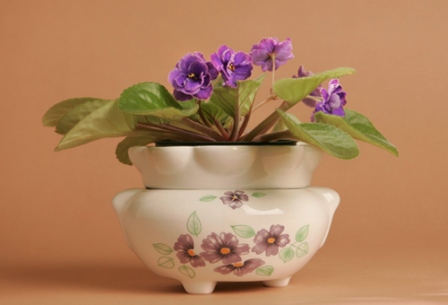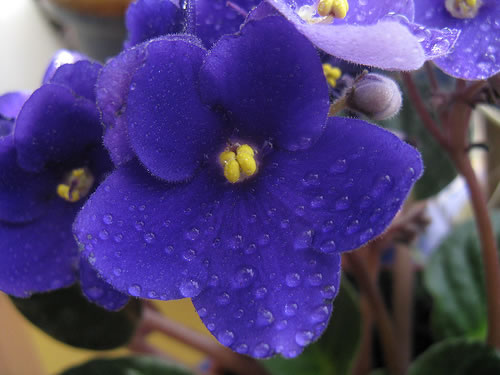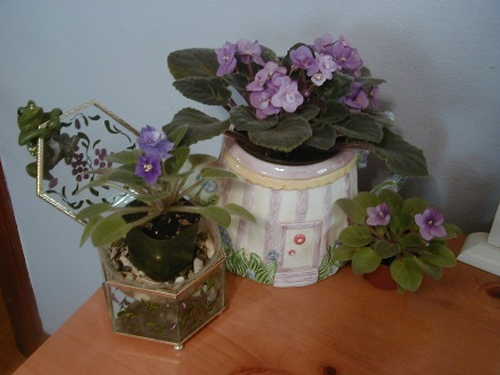African Violets: How to Grow These Blooming Beauties
The first time I saw an African violet at the nursery I was enthralled, but wondered. Would the plant continue to rebloom indoors? Or like many flowering plants you buy at the nursery, would it just be a one-bloom wonder? To my delight, the plant continued to bloom constantly indoors, as does my whole collection.
Grow an African violet (Saintpaulia) and you’ll soon discover why they’re considered one of the most popular flowering houseplants. Give them the right conditions and you can enjoy their pert, happy blooms throughout the year.
African violet flowers come in a variety of striking colors, including purple, pink, mauve, lavender, white, cranberry,coral and blue. Some blooms are variegated. Flowers are single, semi-double or double and are often ruffled or fringed. Leaves are fuzzy and generally oval-shaped, and some are variegated.

African violet origins
Discovered in eastern Africa in 1892 by amateur horticulturist, Baron von St. Paul-Illaire, African violets have been enjoyed by indoor gardeners for over 100 years. A governor of the area’s Usambara District at the time, St. Paul-Illaire spotted a small plant with blue-purple flowers and gathered seeds and specimens. The plant material ended up at Berlin’s Royal Botanic Garden where the director grew plants from the seeds and then identified a new plant genus–Saintpaulia ionantha–after the man who discovered them. Although African violets resemble viola flowers, they are actually in the Gesneriaceae family.
Growing African violets
The secret to getting African violets to look their best and re-bloom is to give them the right growing conditions–which are similar to our preferred living environment, says Irmi Bullinger of Anaheim, who is a member of the Tustana African Violet Society.

“African violets prefer temperatures at 70 to 75 degrees and approximately 60 percent humidity,” she says. “Give them adequate light, water and food, and they’ll thrive.
Lighting
African violets like bright, indirect light. Provide eight to 12 hours of sunlight or artificial light per day. While sufficient light is important for blooming, make sure the sunlight isn’t too bright, or it will burn leaves. An unobstructed, bright northern exposure window is an ideal location. In any other exposure, protect the plants with sheer curtains or adjustable blinds. Keep in mind that in order to bloom,
Watering African violets
African violets should be kept evenly moist, but not overly wet. While you can water them from above as you would many other houseplants, methods that avoid wetting the leaves are preferred.- Watering from the bottom can be done when the surface of the soil has dried out. To water, fill a container that is slightly larger than the plant pot with room temperature or tepid water and place the pot inside. It will slowly soak up water.
- Wick irrigation is another popular watering method. This involves using a wick that sits in a water reservoir down below the plant and is threaded up through the bottom of the pot. The wick continually draws on the water reservoir, transporting just the right amount of water to the plant and never wetting the foliage.
- A wick system can be found at various nurseries and mail-order plant suppliers, or you can make your own, says Bullinger, who notes that it is important to use a synthetic wick material such as acrylic yarn. Cotton or wool do not work well. Thread the wick through the pot and then place it in a water reservoir that has a hole for the wick and a hole for air circulation. Depending on how large the reservoir, wicking can greatly cut down on watering requirements. You need only keep the container filled.
- Avoid highly chlorinated water. If you suspect that your water has a high amount of chlorine, let it sit for several hours before using to let the chlorine gas escape. Softened water should not be used at all because it is too high in salt. Both distilled and reverse osmosis water are good choices.

Fertilizing
Keep African violets blooming by feeding on a regular basis. This can be done monthly, or by adding a quarter-strength solution of fertilizer every time you water. For wick systems, simply add a quarter-strength solution to the water reservoir. Use an all-purpose, well-balanced food such as a 20-20-20, or an organic solution. It is best to use a fertilizer with trace elements, which many organics contain.
Humidity
African violets do best in humid conditions. Wick systems with their water wells provide some humidity. Grouping plants also creates moister air. It is best to grow bottom watered plants over a humidity tray. This is created by placing marbles, gravel or polished pebbles or stones in a tray or larger pot. Fill the humidity tray up with water to just below the surface of the pebbles and place the plant on top, making sure no water touches the bottom of the pot. Refill the tray when it becomes dry.Grooming & pest control
Keeping plants clean and free of old leaves and flowers not only makes the plants look better, it will keep them healthier. If pests do crop up–mealybugs are a likely suspect–spray with isopropyl alcohol. Once the leaves are dry, remove the dried up pests with a soft brush.When to repot African violets
For optimum flowering, African violets should be repotted on a regular basis–about every six months. The rule of thumb is that the pot size should be one-third the diameter of the plant. So if your plant is 9 inches wide, you should use a 3-inch pot. Go up a pot size only when the plant has outgrown the pot. Otherwise, repot in the same container, using fresh soil. Avoid using terra-cotta containers, which lose moisture too quickly. Plastic is your best choice. Soil is important, says Gosnell, who mixes equal parts peat moss, vermiculite and perlite, with a small amount of horticultural charcoal. (The latter ingredient absorbs odors and keeps the soil clean.)Bullinger also makes her own soil mix, but likes it even lighter. “African violet roots need air as much as they need water,” she says. She adds a higher concentration of perlite to her mix to promote air circulation, and a small amount of worm compost for added nutrients and to promote soil health.





